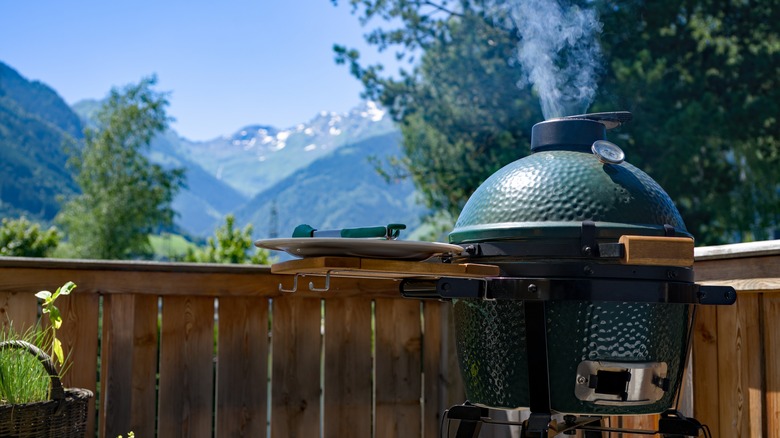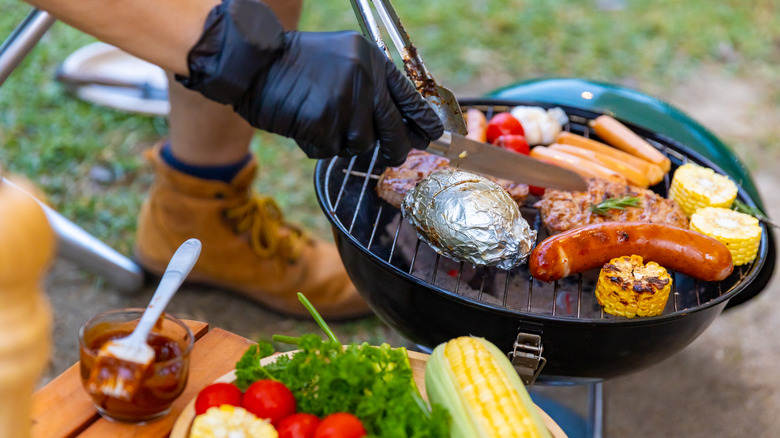What You Need To Know Before Grilling At A Higher Altitude
We make adjustments while cooking all the time, whether it's measuring spice from the heart, or substituting for a missing tool. One adjustment that's of the utmost importance but sometimes overlooked is where you're cooking — not just in a professional kitchen or on a camping stove, but at certain altitudes.
Cooking at high altitudes comes with all manner of adjustments, particularly when grilling. Grilling at high altitude means lowering your cooking temperature to accommodate lower air pressure, adjusting for dry air that will suck the moisture out of your ingredients, and changing your overall cook and prep time. It all boils down to simple scientific adjustments that will keep your barbecue from burning and ensure your meat acclimates just as much as you do. Whether you live miles above sea level or are just vacationing in the mountains, knowing how to grill at high elevation will save your meals from going up in smoke.
How to grill at high altitude
Before focusing on grilling, it's best to know the basics of how high altitudes affect cooking. First and foremost: what is high altitude? According to the U.S. Department of Agriculture, anything above 2,500-3,000 feet is considered high enough altitude to affect cooking. The elevation change has the greatest effect on the boiling point of water, which gets lower as the altitude increases — this means it takes longer for food to cook because you have to keep it stalling at a lower temperature.
What this means for your grill, especially when grilling meat, is that you'll want to maintain as much moisture as possible to prevent food from drying out while cooking. Moisture is also important because water evaporates more quickly at higher altitudes; so you'll be battling slow grilling and quick drying, all affected by the lower boiling point of water in your ingredients. Note that upping the heat and attempting to flash grill your meat will not help, as it will singe the outside of your food and leave the center raw. Your meat, and other ingredients, will also dry out more quickly due to the increased heat.
The moral of the story is when you're grilling up high, keep it low and slow, and this applies to veggies and other grilled items as well. It may seem tedious, but allowing your barbecue to properly heat up and allotting extra time for your food to cook is the only way to go.
Take your grilling to new heights
Grilling at high elevation means focusing on more than just the meat itself, you'll also want to pay attention to your seasonings. Using more water in your rubs or to keep food moist may cause your seasonings to fall off your protein and not stick to it, leaving empty, bland patches. The key to fixing this is packing on more seasoning, and starting for a few minutes at a higher cooking temperature to give the seasoning a chance to stick.
Another key component of grilling is the fire. With a gas grill, you won't have to worry as much about getting your grill up and running, but if you're using a charcoal grill or a campfire, you'll need to bring the heat. Some lighters are only good until about 9,000 feet elevation before they drop in performance or stop working entirely. To guard against this, always have a set of matches on hand and store them in a cool, dry place so you can use them in grill emergencies. This is one of many tips for grilling with charcoal.
Finally, bring a meat thermometer, which you'll want to make sure is as accurate as possible. If you're not used to cooking at altitude, you may throw your chicken breasts on the grill for your typical amount of time, not realizing they'll be underdone. Having a meat thermometer on hand to check your internal protein temperature will ensure the tastiest and safest cooking conditions.


